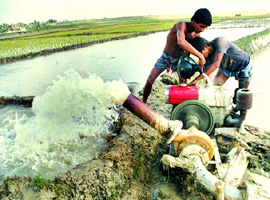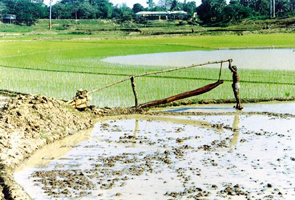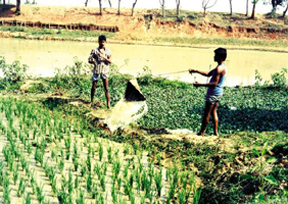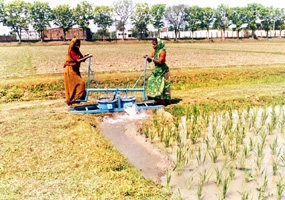Irrigation
Irrigation artificial water supply for dry agricultural land by means of dams, barrages, channels, or other devices. Irrigation has been practiced for thousands of years, chiefly in regions with annual rainfall of less than 500 mm, including many countries of Africa, Asia and America. It is also used in wetter areas to grow certain crops, such as rice. Estimates of total irrigated land in the world range from 543 to 618 million acres, almost half of them in India, Bangladesh, Pakistan, and China. However, the use of canals, dams, weirs, and reservoirs for the distribution, control, and storage of water was probably initiated in ancient Egypt. In modern times, pumps have facilitated the use of underground as well as surface water.
In Bangladesh there has been widespread use of both shallow and deep tube wells for irrigation of agricultural lands, particularly during the dry period (November to March). Since high yielding varieties of rice are very susceptible to drought, these need very frequent irrigation.
Irrigation devices specially designed mechanical appliances used for lifting water either from surface or sub-surface sources for irrigation and domestic purposes. In Bangladesh, 7.56 million ha are suitable for irrigation. But according to the present estimate of available water resources, only about 6.8 million ha can be irrigated. At present only about 3.12 million ha have been brought under irrigation. This indicates that additional 3.68 million ha of rainfed lands can be covered with irrigation. With proper utilization and management, 4.5-5.0 million ha of land can be irrigated by using groundwater.
In Bangladesh, about 94% of the irrigated land is under small and minor irrigation. According to a recent survey, water is being lifted in this country through 26,704 deep tubewells, 4,69,226 shallow tubewells, 56,829 low lift pumps, 1,42,132 manual pumps, and more than 5,65,000 indigenous water lifting devices. But sub-optimal use of these irrigation devices and unplanned cropping activities have resulted in low irrigation coverage. The irrigation efficiency is only about 30%. With proper utilization and improved management, 4.0 to 5.0 million ha of land can be irrigated easily by using the same number of irrigation devices instead of the present 3.12 million ha.
Devices for irrigation water lifting range from age-old indigenous water lifts to highly efficient pumps. Pumps operated by electric motors or engines have come into prominence in all large scale lift irrigation schemes. This is because high output and efficiency levels can be more easily attained and controlled using mechanically powered water lifts.
Selection of a suitable water lifting device for a particular situation depends on the characteristics of the source of water and the lifting device, the amount of water to be lifted, the depth to the pumping water level, the type and amount of power available and the economic status of the farmers.

The irrigation devices commonly used in Bangladesh may be divided into two main categories: (a) motorized pumps, and (b) manual pumps.
Motorized pumps The largest water lifting device for pumping groundwater for irrigation and domestic purposes is the deep tubewell. Generally, the well length is 60-90 m (200-300 ft), the engine Horsepower is 20-30 and the discharge is 56-84 lit/sec (2-3 cusec). The diameter of the pipe varies from 15-25 cm (6-10 inches). Turbine pumps are used for lifting water. They can be operated if the groundwater level is beyond the suction limit.
Motorized irrigation device used to irrigate a smaller area is the shallow tubewell. Generally, the well length is less than 30 m (100 ft), the engine Horsepower is 4-8, and the discharge rate is less than 28 lit/sec (1 cusec). The pipe diameter is 10-12 cm (4-5 inches). At present, shallow tubewells are used intensively in all parts of Bangladesh.
The machine used to pump surface water for irrigation is the low lift pump. The capacity of the pump is higher than that of a shallow tubewell. This system also uses a centrifugal pump which cannot be operated if the water surface of the source exceeds the suction head.
Manual pumps This group of devices for irrigation includes don, swing basket, BRRI diaphragm pump, rower pump, treadle pump, hand tubewell, hand sprinkler and tub.automatically.

Don is a manually operated boat-shaped wooden trough, closed at one end and open at the other. The closed end is tied with a rope to a long wooden pole which is pivoted as a lever on a post. A weight, a large piece of stone, or a ball of dried mud, is fixed to the shorter end of the lever. The open end is hinged to the discharge point. The trough is dipped into the water by applying the body weight and the force of the operator. Water is lifted by the counter weight on the beam and is emptied automatically.
This is an inexpensive water lifting device. It is about 2.4-3.6 m (8-12 ft) long and can lift water up to 0.90-1.2 m (3-4 ft). One person is required to operate the device. This is suitable for small and marginal farmers to irrigate smaller areas with surface water.
Swing basket One of the most ancient water lift devices, consisting of a basket or shovel-like scoop to which four ropes are attached.Two persons stand facing each other and swing the basket to fill in water.

The basket is raised and discharged into the field channel. The device is made of bamboo. It has a simple design and no special structure is required to operate it. It utilizes surface water and can lift water from 0.9m-1.2m (3-4 ft) below the crop field level. It can also be operated by women and minor members of the family.
BRRI diaphragm pump consists of two metal boxes sealed with some rubber sheet and made air tight, which creates a vacuum and lifts water. Two persons are needed for operation. The water lifting capacity is about 80 gallon per minute and both surface and subsurface water sources could be used.
Rower pump It consists of metal pipe with a piston inside. The mechanism is similar to the hand tubewell. It is fixed on the soil surface in inclined position. The operator uses his hands to lift water. It can be used to lift both surface and subsurface water if the water level does not exceed the suction limit.
One person is required for operating the device. It is cheaper than a hand tubewell.
Treadle pump It is used to pump groundwater provided the water level is within the suction limit. Its water lifting capacity is almost the same as that of a hand pump. The operator uses his legs to operate the pump. The cost is less than a hand pump.
Hand tubewell It is generally used for domestic purpose, but can also be used for irrigation. The capacity depends on the efficiency of the operator. It pumps under-groundwater if the water level is within suction limit. The operator uses his hands to operate the pump.
Hand sprinkler It is a can made of light metal and has a nozzle perforated at the top. Filling the can with water, it is sprayed over the crop through the nozzle. It is generally used to irrigate small kitchen gardens.
Tub A light metal dish used to lift water up to 30-60 cm (1 or 2 ft). It can be used for light irrigation. Only surface water can be used to irrigate smaller areas through this device.
Irrigation methods commonly used in Bangladesh include: (a) Basin method This method is widely used for rice irrigation. In this system water is supplied from one side of the plot and the whole plot is flooded with 5-7 cm standing water. Level land is required for successful irrigation by this method. (b) Border method This method is used for slightly sloping land. In this method strong bunds are constructed across a plot of land at a certain interval to retain water in all parts of the plot and to avoid accumulation of water at the lower part of the field. (c) Furrow method This method is suitable for line sown crops, such as sugarcane, potato, etc. Water is supplied through the furrow in between the lines. (d) Sprinkler method This method is mostly suitable for undulated land and for hilly areas. It is also suitable for irrigating very light soil, as the loss of water is kept to a minimum. In this method, water is supplied through pipes and sprayed over the crops through the nozzles in the form of rain.
Irrigation frequency The recurrence of the artificial application of water to land to assist in the production of crops. Grain crops reveal their need for water by wilting temporarily. It is better to base the irrigation schedule on observations made of the moisture status of the soil. The time and frequency of irrigation for some of the important field crops as recommended by the bangladesh rice research institute and bangladesh agricultural research institute are mentioned here:

Rice Continuous standing water in rice field is not necessary. A good yield can be obtained if the soil is in saturated condition from the time of transplanting. The number of tillers increases sufficiently if the field is in saturated condition up to 30-45 days after transplanting. The yield of rice is not hampered if the fields remain dry for 3 days after disappearing of standing water in between each irrigation. Water requirements of rice are maximum at booting and flowering stages. During this period sufficient water should be maintained in the plot to get a good yield. For rice a single excessive irrigation should be avoided. Frequent small irrigation is preferable. The depth of water in each irrigation should be 5-7 cm. Frequency of irrigation can be determined by dividing the depth of irrigation by the water to be depleted from the soil per day.
Supplemental irrigation is beneficial for higher yields of rice, especially if there is drought at the critical growth stages of Aus and T Aman. Generally, around 60 mm water helps increase yields of T Aman. Where irrigation facilities are not available, supplemental irrigation for T Aman is possible through rainwater harvesting. Adequate water (up to 60 mm) for T. Aman can be harvested if a ditch having an area equivalent to 5% of the planted area with 2 m depth is constructed at one corner. Aus paddy can also be cultivated on time if supplementary irrigation can be provided. This will also help in timely planting of Aman.
Wheat For obtaining higher yields generally 2-3 irrigations are required for wheat. But the requirement varies from place to place due to variations in weather conditions and soil types. The first irrigation needs to be applied after 17-21 days of sowing. This irrigation may be delayed if there is sufficient moisture in the soil. Irrigation is needed at heading and grain formation stages. The second irrigation should be applied after 40-45 days and third irrigation after 70-75 days of sowing. The depth of water in each irrigation should be 6-8 cm.
Potato Irrigation is important to obtain high yields of potato. The number of potatoes per plant is reduced if moisture stress occurs at the early stage. The grain size becomes smaller and irregular if moisture stress persists at the later stage. The first irrigation should be applied within 20-25 days of sowing and the second and third within 40-45 and 60-65 days after sowing, respectively. In water shortage areas, if only one irrigation has to be applied, it should be within 20-25 days of sowing.
Maize Generally 4-5 irrigations are required for maize. The time of first, second, third and fourth irrigations are to be applied at 15-20, 30-35, 60-70, and 85-95 days after sowing respectively. The depth of water in each irrigation should be 6-8 cm at the initial stage and 8-10 cm at the later stage. Standing water must be removed at the flowering and grain filling stages.
Sugarcane Irrigation should be applied for 5 to 7 months of crop growth. Usually, 4-5 irrigations are required for sugarcane. Irrigation is not required after flowering. Dry condition of the soil after this stage helps in increasing sugar content of the crop.
Mustard The yield increases if irrigation is applied at the proper time. In most cases, the expected yield is obtained with 2 irrigations, but the range may be 1-3 depending on variety and location. Irrigations should be applied after 25-30 days and 50-55 days of sowing. If the moisture content of the soil is less at the germination stage, light irrigation after 10-15 days of sowing may be helpful.
Onion Frequent small irrigations are preferable for better yield of onion. One or two irrigations should be applied after transplanting of seedlings. Then 4 to 5 light irrigations are required during the whole growing season at an interval of 10-15 days. The depth of irrigation should preferably be 2-3 cm at the early stage and 3-4 cm at the later stage. Standing water in the field is harmful for onion.
Tomato In Rabi season the yield of tomato increases 2-3 times if properly irrigated. Initially irrigation is required daily after transplanting the seedlings. Then the interval may gradually be increased from 3-4 days to 10-12 days. The irrigation depth needs to be 3-4 cm at initial stages and 4-6 cm at later stages.
Irrigation water management In Bangladesh systematic irrigation started in the early 1960s, with the introduction of deep tubewells and low-lift pumps. Before that period, farmers used to grow crops under rainfed conditions. Shallow tubewells came into operation after 1980. Bangladesh has a land area of about 14.4 million ha of which 9.03 million ha (64%) are under cultivation. Irrigation is currently available to less than 50% of the land that can be irrigated in the Rabi season. At present, about 33% of the cultivable land (3.12 million ha) has irrigation facilities. This amounts to about 21.6% of the total cropped area.
Irrigation has revolutionized rice production in Bangladesh. However, limited irrigation is used for non-rice crops. The rice crop alone occupies 90-95% of the irrigated area and only 5-10% is left for other crops. Cultivation of modern variety (MV) of rice during the Boro season (substitute crop of wheat) is almost entirely dependent on irrigation water. Both small and minor scale irrigation systems play the dominant role in MV Boro rice cultivation. On the other hand, irrigation for Aus and T. Aman has also an important impact. The early part of Aus and the later part of T. Aman crops sometimes suffer from water stress. Supplemental irrigation in these two stages will promote MV rice adoption and also ensure stable and better crop yields. Some selected crops such as wheat, millet and potatoes can be produced with residual soil moisture. Application of one or two irrigations can substantially increase the yield of these crops.
In Bangladesh, optimum use of irrigation water should play an important role in increasing agricultural production. Overall development of the country's agricultural sector will require year-round use of irrigation facilities for productive use of water. The country will benefit substantially through improvements in the allocation and distribution of the available water.
In this country about 95% of the rainfall occurs during April to October, leaving the winter months, ie November to March, very dry. Therefore, irrigation is a prerequisite for obtaining stable high yields during the dry season. Supplemental irrigation may also be needed in the event of a drought, so that Aus and Aman rice crop can make intensive use of the land.
The demand for irrigation water is increasing day by day and the cost is increasing accordingly. By minimizing losses of irrigation water, more area can be irrigated with the same volume of water. If proper water management is practiced agricultural production can be increased through either higher yield or larger irrigated areas. Therefore, the importance of proper water management has widely been accepted by those concerned with irrigation and crop production.
The rising cost of fuel, oil, and irrigation equipment demands optimum and efficient utilization of irrigation water to make facilities economically viable. For optimum yields, due regards should be given to the soil, plant and water relationships through proper management of water. [Md. Abdur Rashid]
Minor irrigation comparatively smaller, easier and cheaper means of the artificial application of water to land to assist in the production of crops. Although Bangladesh is blessed with vast water resources suitable for irrigating the cultivable land, the resources show a unique annual cycle, from abundance in wet season to scarcity in dry season. It is difficult to utilize fully the huge water resources for the benefit of the country due to social, economical, financial and technical constraints. Though efforts have been made to develop some major irrigation, flood control and drainage projects, desired results from these projects are yet to be achieved. To meet the need for increased food production, minor irrigation is being widely used. In fact, its is regarded as a 'Quick Yielding' technology for irrigation in Bangladesh. It includes Low Lift Pumps (LIPs), Deep Tubewells (DTWs), Shallow Tubewells (STWs), Deep Set Shallow Tubewells (DSSTWs), Very Deep Set Shallow Tubewells (VDSSTWs), Force Mode Tubewells (FMTWs), Cavity wells, Artesian wells, Treadle pumps, Rower pumps, Floating pumps etc. Indigenous small water lifting devices such as swing baskets, doons, shadoofs etc are also used as minor irrigation equipment.
Minor irrigation facilities play an important role in crop production. The net cultivable land of Bangladesh is about 9.03 million ha, of which about 7.56 million ha are considered irrigable. Of the total irrigated area (about 3.12 million ha) in 1994-95, minor irrigation alone covered more than 92%.
Since independence in 1971, minor irrigation has been contributing significantly to agricultural production. Several studies have shown that each hectare of irrigated land yields about two and a half metric tons of additional food grains. It has enhanced the income and thereby improved the living standard of farmers. Minor irrigation ensures the production of risk free dry season crops and facilitates the utilization of high yielding variety seeds, fertilisers, insecticides etc. It helps increase the intensity of cropping and creates rural employment opportunities, and promotes competitive markets. It is accessible even to poor and marginal farmers of all irrigable areas, including those in the difficult and backward regions of the country. [Md Zahidul Islam]
See also agriculture; crop; farming system.
